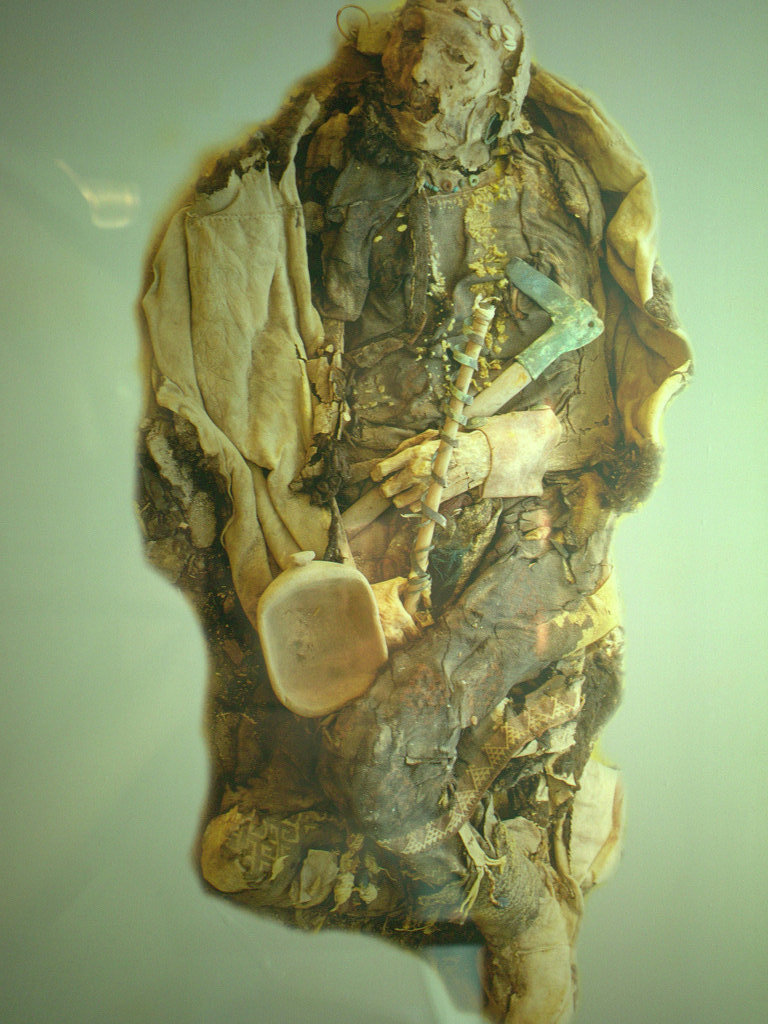
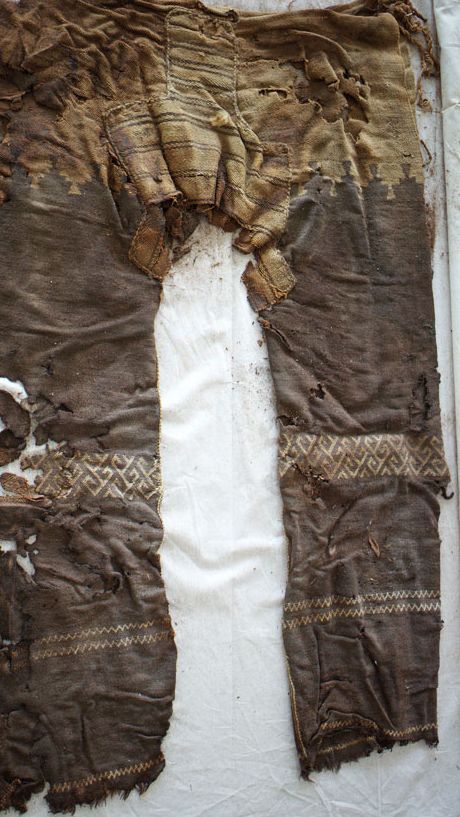
But the other unmentioned traits are also gems of the picture. The riding boots, which are “extremely uncomfortable when walking”. The assertion that Türkic nomads brought boots footwear to the civilized and uncivilized sedentary world was asserted by the Turkologists for ages, and was taken up with sneers and scorn. The uncouth old mummy makes fools of the generations of the prejudiced carpers.
The caftan illustrates the accuracy of the Chinese annals, it is lapelled to the left, in contrast with the Chinese robes lapelled to the right. For the much later Chinese of the Han period, the lapel to the left was a sign of barbarism and a reason for permanent consternation. Great efforts of the much later Celestial empires were futilely spent on attempts to re-educate millions of barbarians to switch to the real civilized fashion. In the end, some of those millions joined Chinese people and turned into bona fide Chinese in right lapelled robes. Some of those Chinese retained their old ethnic name Hu, like Hu Jintao 胡锦涛.
The horsewhip was needed to accompany the deceased to the Tengri for reincarnation. In the year 1400 BC, the Buddhism had not been invented yet. It would take another 800 years to come up with the Buddhism and its reincarnation. By that time, kurgans, Tengriism, and reincarnation would have existed for about 6 millennia. Probably not in the same form as they came down to us, but the kurgans and travel necessities attest to the intended travel and reincarnation. The horse or horses of the Zhou traveler must have been interred in the immediate proximity of the deceased, otherwise he would not have grabbed a horsewhip to go along. Unfortunately, the pants' people do not report on the horse remains and its DNA, to give us a complete picture of his mount.
The DNA of the Tarim people is politically highly charged and therefore is a guarded Chinese state secret subject, largely known from years of sensationalized and highly demagogued reports on Caucasoid “Indo-Europeans” speaking “Tokharian” language on one side, and Chinese counter demagogy on the other side. The available bits and pieces suggest Central Asian (read: Türkic) and Indian males and mostly local eastern ladies. Confusion, densely airbrushed by population genetics, blots the picture, leaving metallurgy to lead the field with precise, verifiable, and consistent data.
The blondishness of the Tarim horse nomads comes from the Ugro-Fennic stock described in the metallurgical, anthropological, and genetic tracing. Ironically, although the Ugro-Fennic blondishness is oddity in Europe and in the Indo-European stock, it has been sold as an innate trait of the Indo-Europeans, and was sold as such for many years. Nothing new came in genetics for the blondishness, it is still either Ugro-Fennic or Melanesian. The E.N. Chernykh's tracking of metallurgy explains the process of amalgamation of the nomads with the Ugro-Fennic hunters very clearly. So does T. Chikisheva's Anthropology of South-Western Siberians. Hence, the blond Tarim nomad. In their drives to the east and west, the nomads could not escape bringing their traits to Europe and Far East. Hence, the blond Europeans, endemic in the Ugro-Fennic ancestral territories of the Eastern Europe, the blond Far Easterners, and the blond South Asians. Light hair and eyes may be exclusively female inheritance, independent of Y-DNA, it can be a natural consequence of the well-known brunettes' weakness for the blonde beauties.
The most striking is the tubular socket ax, an implement so unique and diagnostic that it beats by a mile the 3400-year aged model of the Saint Laurent pants. The tubular socket ax is an oddity in the world of axes, it is known from the early period of the bronze casting, and only from the limited areas of northern hills of the Mesopotamia, Altai and surrounding South Siberia, and the northern areas of what is China today. It is known from the tombstone sculptures routinely attributed to the Scythians (or Cimmerians), and dated accordingly to the post-9th cent. BC. That dating surely needs verification by instrumented methods. The tubular socket axes belong to the Steppe Metallurgy named by E. Chernykh East Asian Metallurgical Province (Chernykh E. Steppe Metallurgy). The Middle Bronze Age metallurgical period of 1900-1200 BC includes constituent archeological cultures of 3300 - 2300 BC for Pit Grave Culture, 2, 500 - 1, 500 BC for Afanasiev Culture, 1900 - 1200 BC for Timber Grave Culture, 1800 - 1200 BC for Andronov Culture, 1400 - 700 BC for Karasuk Culture. In the metallurgical periodization, they belong to the third stage of the East - West sprawl in the 3rd-2nd mill. BC. The early phase of the Eurasian province, dated 28-22 centuries BC, is remarkable because of the start of two swift counter-propagating “waves” of the pastoral peoples' migration from the west to the east and from the east to the west that left their tubular socket traces in Mesopotamia, South Siberia, and the northern China of today.
The tubular socket ax was but a single component of the “Scythian complex” that also included other peculiar metallurgical and non-metallurgical objects, not necessarily interred with the deceased as attire or travel utensils. These distinct objects included symbolic bronze knifes that with time turned into round and squàre coins, and turtle shell notebooks that arrived with the Zhou people. This traceable unique model of the ax allows to connect the Guties in the west with the Zhous in the east, and speculate that Guties stand for Guzes, a genetic Türkic for “tribe”, and Zhous stand for Juz, a genetic Türkic for “union, tribal confederation”. The Juz still stands for “union” in Kazakhstan, and is Üz in Slavic (Þç), which has a form Souz (Ñîþç), like in the name USSR (ÑÑÑÐ) where the first Cyrillic C stands for Souz (Ñîþç). The Turkic word in the title of the country survived Stalin's pogroms and deportations not because of the kindness of the thugs, but because of their blatant ignorance.
The contents of the breaking news
Archaeologists in China have uncovered in the Yanghai graveyard in the Tarim Basin the world's oldest pants, age ca 3.3 thousand years. It is the most ancient pants ever found on earth. They are decorated with embroidery. The tailoring involved no cutting: pant sections were shaped on a loom in the final size. Trousers was sewn together from three pieces of brown-colored wool cloth, one piece for each leg and an insert for the crotch. Finished pants included side slits, strings for fastening at the waist and woven designs on the legs. Experts believe that the pants belonged to one of Asian nomads. The find confirms that the nomads sewed special clothing to ride on horseback.
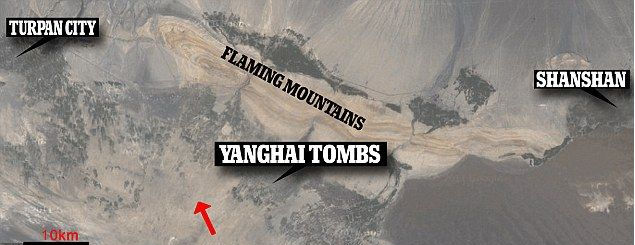
Ulrike Beck and Mayke Wagner of the German Archaeological Institute in Berlin studied together with colleagues two pairs of woolen trousers burial in Eastern Turkistan. Radiocarbon analysis showed that they were about 3, 300 - 3, 000 years old.
For most of the ancient history people wore gowns, robes, tunics, togas or, as observed on the 5, 300-year-old body of Ötzi the Iceman, a three-piece combination of loincloth and individual leggings. Trousers is a relatively recent innovation. Until now, the oldest pants were considered to come from Nepal, their “age” is only 2, 400 years. Earlier, the locals wore skirts and capes. But when riding appeared, it came with pants.
According to scientists, this confirms the long-held assumption that the appearance of the first pants was associated with the horse riding. The woolen trousers had in the crotch sewn a piece of fabric protecting this part of the human body, and provided a closer grip of the inner thigh, required at riding on a horseback.
The scientists were struck by another another find. Reconstruction of the findings showed that the wide crotch part of the ancient pants was hanging by folds, exactly in a fashion of the Türkic pants one still can see in Turkey. One of the Wagner colleagues tried the pants sewn after the patterned of the oldest pants, and concluded that they were “extremely uncomfortable when walking”. M. Wagner commented: “While walking, the internal parts of the legs, the crotch and the lower abdomen are not subjected to a long period of friction. The problem becomes acute only when riders have to spend a lot of time on horseback.” Apparently, the Turkish men however have no problems wearing riding trousers as a daily attire.
The discovery attests that the horse riding existed in the Tarim Basin three and a half thousand years ago. Over the ages, Central Asia passed through cyclical periods of aridification and humidification, driving out and attracting nomadic pastoralists.
Other illustrations related to the theme, cannibalized from other related articles:
Emergence of the Eurasian Metallurgical Province
Asterisks denote tombs and sanctuaries, points and oval shapes denote isolated finds of metal of the Seima-Turbino appearance
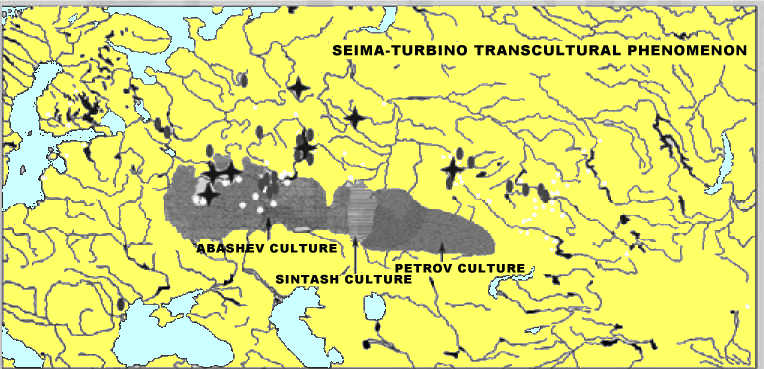
The initiators of the nomadic movement were people who left behind monuments where archaeologists recognize the so-called Sintashta or Abashevo-Sintashta community. The Petrov culture also belonged to that community. As before, the populations of that community disdained agriculture, and without doubt, the animal husbandry remained central to their daily lives. Also, on the basis of the copper ore deposits east of the Urals and in Kazakhstan, there was successfully developing metal mining industry.
The kurgan cemeteries almost disappeared beyond the Urals: the ancient ritual of construction grave mounds was quickly dying there. Archaeologists discovered many villages of that community, but as a rule the settlements were not impressive with their large size.
The Sintashta/Abashevo/Petrov culture display typical traits of the peaceful colonization and amalgamation. The aboriginal foot hunter population continued their traditional non-producing economy, with large tracts of forest needed for the sustenance of each family; that limited the size of the villages farming natural resources within the immediate vicinity. The newcomers brought along their producing animal husbandry economy that did not compete with the aboriginal economy. They engaged aborigines into metal production as suppliers of the ore and charcoal, and possibly of the ingots. On the social level, amalgamation went on as inter-ethnic marital unions. In the lingo of physical anthropology, the nomads of the western part of the steppe belt are termed Southern Eurasian Anthropological Formation; these are the people called Kurgans within the Indo-European linguistic Urheimat hypothesis. The northern foot hunters are termed Northern Eurasian Anthropological Formation, they occupied the northern belt of Eurasia from the White Sea to the Baraba steppes, and are termed archeologically Pit–Comb Ware Cultures (V.Bunak, 1956, T.Chikisheva, 2010).
Like the Pilgrims vs. Amerindians, like the conquistadors vs. Mesoamericans, and like any other colonial expansion, the nomadic newcomers are relatively few, and barely visible archeologically; but their visibility may be relatively high if the visibility of the aboriginal archeological backdrop is even less prominent, and if their archeological culture is very distinct. Soon, their offsprings become physically indistinguishable from the aboriginal population, except for their continued economical and social traditions, observed as disappearing kurgan cemeteries. The economical and marital compacts may continue indefinitely, until a new upheaval changes the scenery.
The second nomadic “wave” (or the eastern impulse) very quickly arose a very developed type of metallurgy in the vast areal of the Sayano-Altai mountain system. The relatively primitive metallurgical centers of the preceding period went through a sudden burst of high-tech production of thin-walled bronze castings of fine and perchance unique forms of weapons. There were cast spearheads, kelt axes, curved knives with sculpted images of various animals and even humans (Fig. 8). The vast majority of these objects were found in very strange cenotaph graves, where archaeologists have found no human remains. The width of the distribution area of these unusual antiquities is amazing: from the Western and even Central China, to the Eastern Baltic, i.e., more than six thousand km. But in this enormous territory were found surprisingly small number of these metal objects, not more than six hundred.
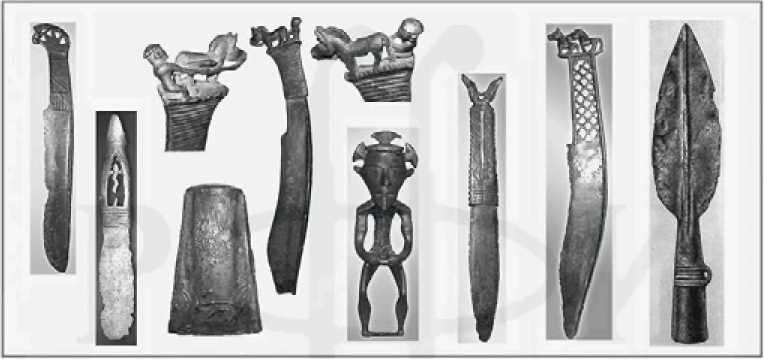
Emergence of the East Asian Metallurgical Province
Some clue on the origin of the East Asian Metallurgical Province is given by the provenance of the unique tubular socket axes, that follow the practice of tubular socket arrowheads and spear blades. Such tubular socket axes were found in Mesopotamia, in the Altai, and in the Northern China. In the Mesopotamia, they are attributed to the nomadic horse cattlemen Guties (Guzes), Turuks (Türk), Komans (Kumans), Kangars, Subars, and Lulu, in China they are associated with the nomadic horse cattlemen Zhou (Jous, Juz “union, tribal confederation”) and Juns (Rongs, probably standing for Huns), in the Altai they are associated with the Seima-Turbino metal production.
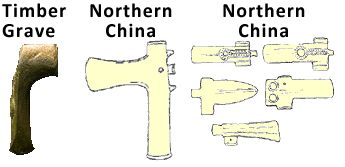
That was a birth of another great metallurgical province, which is called East Asian Metallurgical Province. Compared with the Eurasian Metallurgical Province it had a much more complex structure.
In the archeology, the eastern “wave” is known as the Seima-Turbino transcultural phenomenon (after two famous cemeteries: Seima and Turbino). The warlike nomadic populations rapidly moved westward in parallel, but to the north from the oncoming wave of the Abashevo-Sintashta tribes, primarily along the southern strip of the Eurasian forest zone. 35-40 centuries later by the same path heading eastward would as swiftly move small Cossack detachments, these restless and undisciplined subjects of the Russian state. Cossacks were Türkic mercenaries of various tribal ethnicity, generally defined by their ancestral location: Yaik Cossacks, Don Cossacks, Terek Cossacks, etc. Cossacks were hired for a determined season, or a determined campaign or task.
However, in the second half of the 2nd mill. BC the nomadic pastoralists of the East Asian Metallurgical Province dramatically changed the orientation of their aggressive intentions. Henceforth, their eyes focused mainly on the southeast (Fig. 9), where rose richest cultural centers of the ancient Chinese state called Shang (Yin), which centers are mainly connected with the Huanhe (Yellow River) basin. The steppe extracts, whose culture archaeologists call Karasuk, inherited many weapons forms from the prior Seima-Turbino phenomenon, first of all casting the so-called single-edged curved knives with decorated handles (Fig. 8). These forms of weapons, or rather their imitations, spread throughout the territory of the Shang principality. Apparently, from that time originated the great confrontation between the steppe pastoral warriors and ancient and medieval Chinese civilizations.
The western leg of the eastward migration passes the Tarim Basin, carrying the left lapelled caftans, oldest riding pants,
riding boots, tubular socket axes, horsewhips, ceramic flasks, kaury (cowrie, cowry) shell diadems, dress buttons, etc.
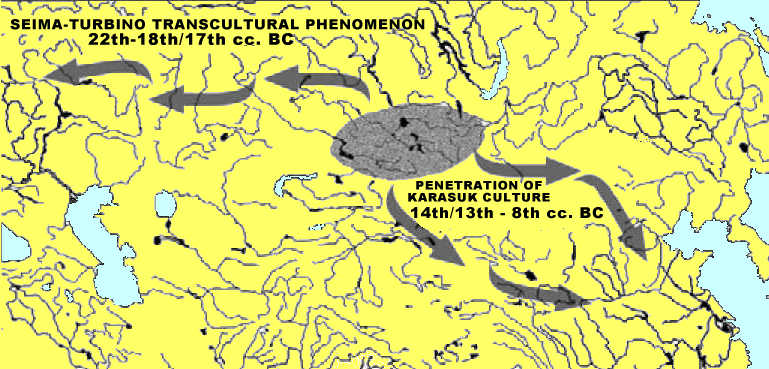
| Figure 3.25. Bronzes of northern style, from Fu Hao's tomb. (a) Knife. (b) Minors. (c) Bow-shaped object | Figure 3 39 Objects from various finds at Shilou, Shanxi. (a) Gold earrings with turquoise beads. (b) Bronze arc (head ornament?) (Hunnic diadem). (c) Battle axe with tubular shaft hole. (d) Wand or spatula. (g) Ladle. (f) Bell-shaped rattle. (g) Boat shaped vessel | Figure 3.36. Axes. Same scale, (a) Axe of the type yue. (b) Axe of the type ge. (c) Axe with tubular socket |
|---|---|---|
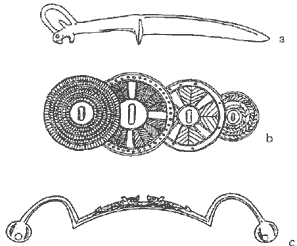 |
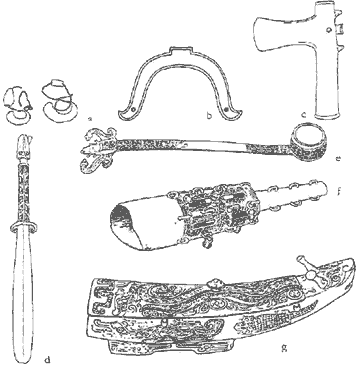 |
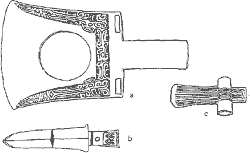 |